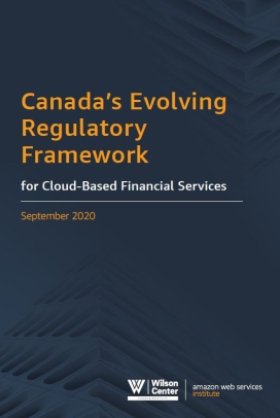Canada’s Evolving Regulatory Framework for Cloud-Based Financial Services


Executive Summary
Digital transformation in the global banking industry requires Canadian financial services regulators to consider how to update rules and procedures created for traditional banking and financial services to reflect the new realities of financial services—increasingly conducted online and in the cloud. The challenge that governments and business face is how to uphold their longstanding objectives of customer security and financial stability while also helping to create an environment that enables innovation.
The stakes are high. Canada’s financial system has long been a global model of stability and security, consistently ranking among the top two or three in the world for soundness of banks. At the same time, Canadian firms are unable to take advantage of the same opportunities as competitors in other parts of the world—due in part to regulatory gaps and uncertainties. Cloud-based storage and computing pose a particular challenge for regulators because there is a continuing bias towards on-premises infrastructure. Even though, there is ample evidence that hyperscale cloud service providers like AWS enable organizations to strengthen their own compliance and certification programs and automate manual security tasks so they can shift their focus to scaling and innovating.
To provide Canadian customers with the financial services they demand and position Canadian firms for global competitiveness, industry representatives recommend that new rules around the use of technology in the financial services sector be clear and transparent. They also recommend that government and industry work together to eliminate unnecessary duplication between jurisdictions and that regulators seek to understand better the security benefits of cloud storage facilities as compared to on-premises infrastructure.
Introduction
Consumers today expect financial services to be simple: they purchase goods or services on a mobile phone while watching television or waiting to board a plane and they want the same convenience when managing their finances. (1) Not that long ago, such transactions would have been impossible without a trip to the bank. Today, financial institutions demonstrate how much the landscape has changed. A case in point is the UK’s Starling Bank. It has no physical branches, but it is consistently voted one of Britain’s top banks for customer service. Fintech companies have emerged in every financial services vertical for money transfer, e-credit card, and lending solutions, among other services. (2) Much of the convenience and availability of new services can be attributed to the rise of cloud technology.
But, customer convenience is only part of the story. Cloud-based technologies are enabling financial services institutions (FSIs) to provide innovative products while also enhancing their security, data storage capacity, and computing power. McKinsey & Co. forecasts that between 40 and 90 percent of bank activities globally could be done in the cloud by the late 2020s.
At the same time, new technologies raise questions about how to ensure that new ways of doing things are compatible with the bedrock priorities of consumer protection and the stability of the national and global financial systems. As cloud becomes an integral part of financial service delivery, regulators in Canada and around the world are seeking to understand how to fully leverage the security and innovation that cloud provides within a framework of regulations and enforcement procedures intended for brick-and-mortar FSIs.
This report examines how Canada’s financial services sector is taking advantage of cloud computing to compete in a rapidly changing marketplace, and it describes how the evolving regulatory framework will affect the sector’s ability to compete globally. The report draws from insights provided by finance industry leaders who shared their perspective with the authors at a roundtable hosted by the Canada Institute and the AWS Institute in Toronto, Ontario on July 18, 2019. (3) The recommendations presented in this report are drawn from that conversation.
1 A 2019 poll done for the Canadian Bankers Association showed that 32 percent of Canadian financial transactions take place on a mobile device. That percentage is expected to jump to 41 percent by 2024.
2 See, for example, TransferWise, NuBank and Robinhood.
3 On July 18, 2019, the Wilson Center’s Canada Institute and the AWS Institute hosted a stakeholder roundtable in Toronto, Ontario entitled “Moving Canada’s Financial Sector Forward: Building Smart Policies for Smart Technologies. The invitation-only event brought together policy, industry, and academic experts to discuss financial sector adoption of cloud-based processes. The meeting observed Chatham House rules and the report paraphrases participant comments, except when cited with the permission of the speaker.


Canada Institute
The mission of the Wilson Center's Canada Institute is to raise the level of knowledge of Canada in the United States, particularly within the Washington, DC policy community. Research projects, initiatives, podcasts, and publications cover contemporary Canada, US-Canadian relations, North American political economy, and Canada's global role as it intersects with US national interests. Read more

Explore More
Browse Insights & Analysis
360° View of How Southeast Asia Can Attract More FDI in Chips and AI


